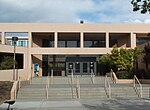University of New Mexico
The University of New Mexico (UNM; Spanish: Universidad de Nuevo México) is a public research university in Albuquerque, New Mexico. Founded in 1889 by the New Mexico Territorial Legislature, it is the state's oldest university, flagship academic institution, and the largest by enrollment, with over 25,400 students in 2021. UNM comprises twelve colleges and schools, including the only law school in New Mexico. It offers 215 degree and certificate programs, including 94 baccalaureate, 71 master and 37 doctoral degrees. The main campus spans 800 acres (320 ha) in central Albuquerque, with branch campuses in Gallup, Los Alamos, Rio Rancho, Taos, and Los Lunas. UNM is identified as having "very high research activity" by the Carnegie Classification. According to the National Science Foundation, it spent over $243 million on research and development in 2021, ranking 103rd in the U.S. UNM is classified as a Hispanic-Serving Institution (HSI) by the U.S. Department of Education, with nearly half its students being Hispanic.UNM's 16 varsity sports programs, known as the Lobos, compete in NCAA Division I (FBS for football) and are members of the Mountain West Conference; the school has won national championships in skiing and cross country running. UNM's official colors are cherry and silver. The school has approximately 200,000 alumni worldwide.
Excerpt from the Wikipedia article University of New Mexico (License: CC BY-SA 3.0, Authors).University of New Mexico
Vassar Drive Northeast, Albuquerque Nob Hill
Geographical coordinates (GPS) Address External links Nearby Places Show on map
Geographical coordinates (GPS)
| Latitude | Longitude |
|---|---|
| N 35.08389 ° | E -106.61861 ° |
Address
University of New Mexico (UNM)
Vassar Drive Northeast
87131 Albuquerque, Nob Hill
New Mexico, United States
Open on Google Maps







